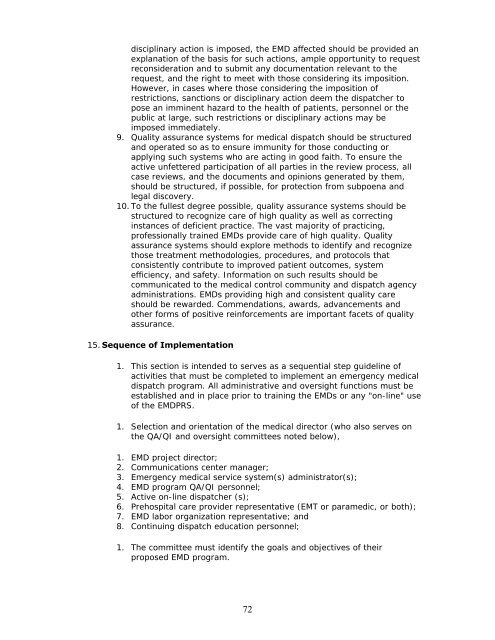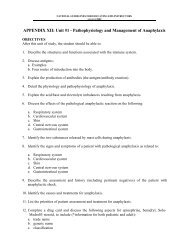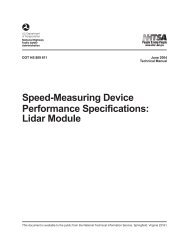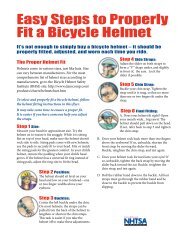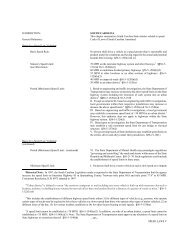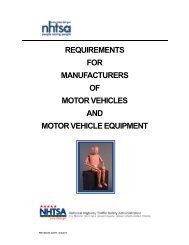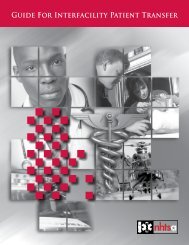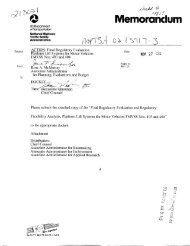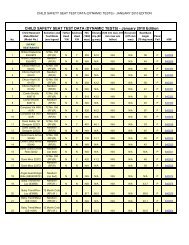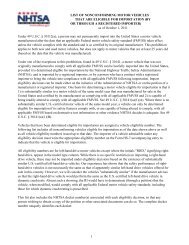Standard Practice for Emergency Medical Dispatch ... - NHTSA
Standard Practice for Emergency Medical Dispatch ... - NHTSA
Standard Practice for Emergency Medical Dispatch ... - NHTSA
Create successful ePaper yourself
Turn your PDF publications into a flip-book with our unique Google optimized e-Paper software.
disciplinary action is imposed, the EMD affected should be provided an<br />
explanation of the basis <strong>for</strong> such actions, ample opportunity to request<br />
reconsideration and to submit any documentation relevant to the<br />
request, and the right to meet with those considering its imposition.<br />
However, in cases where those considering the imposition of<br />
restrictions, sanctions or disciplinary action deem the dispatcher to<br />
pose an imminent hazard to the health of patients, personnel or the<br />
public at large, such restrictions or disciplinary actions may be<br />
imposed immediately.<br />
9. Quality assurance systems <strong>for</strong> medical dispatch should be structured<br />
and operated so as to ensure immunity <strong>for</strong> those conducting or<br />
applying such systems who are acting in good faith. To ensure the<br />
active unfettered participation of all parties in the review process, all<br />
case reviews, and the documents and opinions generated by them,<br />
should be structured, if possible, <strong>for</strong> protection from subpoena and<br />
legal discovery.<br />
10. To the fullest degree possible, quality assurance systems should be<br />
structured to recognize care of high quality as well as correcting<br />
instances of deficient practice. The vast majority of practicing,<br />
professionally trained EMDs provide care of high quality. Quality<br />
assurance systems should explore methods to identify and recognize<br />
those treatment methodologies, procedures, and protocols that<br />
consistently contribute to improved patient outcomes, system<br />
efficiency, and safety. In<strong>for</strong>mation on such results should be<br />
communicated to the medical control community and dispatch agency<br />
administrations. EMDs providing high and consistent quality care<br />
should be rewarded. Commendations, awards, advancements and<br />
other <strong>for</strong>ms of positive rein<strong>for</strong>cements are important facets of quality<br />
assurance.<br />
15. Sequence of Implementation<br />
1. This section is intended to serves as a sequential step guideline of<br />
activities that must be completed to implement an emergency medical<br />
dispatch program. All administrative and oversight functions must be<br />
established and in place prior to training the EMDs or any "on-line" use<br />
of the EMDPRS.<br />
1. Selection and orientation of the medical director (who also serves on<br />
the QA/QI and oversight committees noted below),<br />
1. EMD project director;<br />
2. Communications center manager;<br />
3. <strong>Emergency</strong> medical service system(s) administrator(s);<br />
4. EMD program QA/QI personnel;<br />
5. Active on-line dispatcher (s);<br />
6. Prehospital care provider representative (EMT or paramedic, or both);<br />
7. EMD labor organization representative; and<br />
8. Continuing dispatch education personnel;<br />
1. The committee must identify the goals and objectives of their<br />
proposed EMD program.<br />
72


